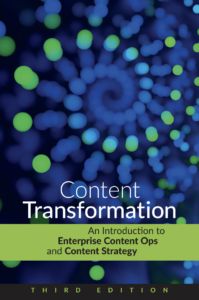Author: Christine Cuellar
Your customers expect intelligent, AI-powered experiences. Is your content strategy ready for an AI-driven world? After a popular panel at ConVEx San Jose, the team at CIDM brought the conversation online in this webinar.
AI is going to require us to think about our content across the organization, across the silos, because at the end of the day, the AI overlord, the chatbot is out there slurping up all this information and regurgitating it. The chatbot doesn’t care that, for example, I work in group A, Marianne’s in group B, and Dipo’s in group C, and we don’t talk to each other. The chatbot, the world, the consumer, sees us all in the same company. If we’re all part of the same organization, why shouldn’t it be consistent?
— Sarah O’Keefe
Struggling with enterprise content strategy? Our principal advisory sessions will get you on track.
We have several great events lined up for the summer of 2025. Here’s where you can see Scriptorium in action.
Trying to eliminate costly content errors, increase brand consistency, and create content at scale? Consider content reuse.
In this episode, Alan Pringle, Bill Swallow, and Christine Cuellar explore how structured learning content supports the learning experience. They also discuss the similarities and differences between structured content for learning content and technical (techcomm) content.
Even if you are significantly reusing your learning content, you’re not just putting the same text everywhere. You can add personalization layers to the content and tailor certain parts of the content that are specific to your audience’s needs. If you were in a copy-and-paste scenario, you’d have to manually update it every single time you want to make a change. That scenario also makes it a lot more difficult to update content as you modify it for specific audiences over time, because you may not find everywhere a piece of information has been used and modified when you need to update it.
— Bill Swallow
With a LearningDITA group license, your company has centralized course management for your DITA team training. You can buy course licenses in bulk, assign courses to individual team members, and keep track of course completion. As your team grows, you can increase your quantity of course licenses or add new courses. Our group licensing page tells you how!
Your wait is over! LearningDITA is open again, and it’s running on a new platform to give you a better learning experience.
Here’s where you can see our team in action in 2025!
In this episode of our Let’s Talk ContentOps! webinar series, special guest Rahel Bailie, Content Solutions Director of Technically Write IT, and host Sarah O’Keefe, Founder & CEO of Scriptorium, discuss how organizations can leverage the unlikely connection between structured content and conversational AI.
In this webinar, attendees learn:
- What is structured content, and how it fuels reliable conversational AI responses
- How technical writers and conversation designers can collaborate for optimal output
- Where to get started with structured content and conversational AI
Did you miss a podcast, blog post, or webinar? We get it–there’s too much content and not enough time, but we’ve got you covered. Here’s a collection of our biggest topics from this year.










